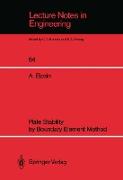- Start
- Plate Stability by Boundary Element Method
Plate Stability by Boundary Element Method
Angebote / Angebote:
1. 1 Historical Background Thin plates and shells are widely used structural elements in numerous civil, mechanical, aeronautical and marine engineering design applications. Floor slabs, bridge decks, concrete pavements, sheet pile retaining walls are all, under normal lateral loading circumstances, instances of plate bending in civil engineering. The problem of elastic instability of plates occurs when load is applied in a direction parallel to the plane of the plate. The deck of a bridge subjected to a strong wind loading, the web of a girder under the action of shear forces transmitted by the flanges, the turbine blade of a machinery undergoing longitudinal temperature differentials, would all eventually buckle when the applied load, or its temperature equivalent in the last case, exceeds a certain limit, that is the buckling load. Although the plate may exhibit a considerable post-buckling strength, the buckling load is considered in many design instances, especially in aeronautical and marine engineering, as a serviceability limit because of the abrupt and substantial change in the dimensions and shape of the buckled plate. Nevertheless, the post-buckling region retains its importance either as an essential safety margin or as a stage of loading actually reached under normal loading conditions. The design engineer will therefore need rigorous tools of analysis to predict, in addition to the buckling load, the deflections and stresses at both buckling and initial post-buckling stages.
Folgt in ca. 5 Arbeitstagen
